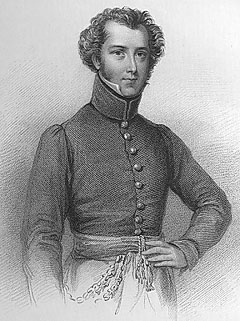| Alexander Gordon Laing  Born: 27-Dec-1793 Born: 27-Dec-1793
Birthplace: Edinburgh, Scotland
Died: 26-Sep-1826
Location of death: Near Timbuktu
Cause of death: Murder
Gender: Male
Race or Ethnicity: White
Sexual orientation: Straight
Occupation: Explorer Nationality: Scotland
Executive summary: Explorer killed returning from Timbuktu Scottish explorer, the first European to reach Timbuktu, was born at Edinburgh on 27 December 1793. He was educated by his father, William Laing, a private teacher of classics, and at Edinburgh University. In 1811 he went to Barbados as clerk to his maternal uncle Colonel (later General) Gabriel Gordon. Through General Sir George Beckwith, governor of Barbados, he obtained an ensigncy in the York Light Infantry. He was employed in the West Indies, and in 1822 was promoted to a company in the Royal African Corps. In that year, while with his regiment at Sierra Leone, he was sent by the governor, Sir Charles MacCarthy, to the Mandingo country, with the double object of opening up commerce and endeavouring to abolish the slave trade in that region. Later in the same year Laing visited Falaba, the capital of the Sulima country, and ascertained the source of the Rokell. He endeavoured to reach the source 01 the Niger, but was stopped by the natives. He was, however enabled to fix it with approximate accuracy.
He took an active part in the Ashanti War of 1823-24, and was sent home with the despatches containing the news of the death in action of Sir Charles MacCarthy. Henry, 3rd Earl Bathurst, then secretary for the colonies, instructed Captain Laing to undertake a journey, via Tripoli and Timbuktu, to further elucidate the hydrography of the Niger basin. Laing left England in February 1825, and at Tripoli on 14 July he married Emma Warrington, daughter of the British consul. Two days later, leaving his bride behind, he started to cross the Sahara, accompanied by a sheikh who was subsequently accused of planning his murder. Ghadames was reached, by an indirect route, in October 1825, and in December Laing was in the Tuat territory, where he was well-received by the Tuareg. On 10 January 1826 he left Tuat, and made for Timbuktu across the desert of Tanezroft. Letters from him written in May and July following told of sufferings from fever and the plundering of his caravan by the Tuareg, Laing being wounded in twenty-four places in the fighting. Another letter dated from Timbuktu on 21 September announced that his arrival in that city had been the preceding 18 August, and warned of the insecurity of his position owing to the hostility of the Fula chieftain Bello, then ruling the city. He added that he intended leaving Timbuktu in three days time. No further news was received from the traveller. From native information it was ascertained that he left Timbuktu on the day he had planned and was murdered on the night of 26 September 1826. His papers were never recovered, though it is believed that they were secretly brought to Tripoli in 1828. In 1903 the French government placed a tablet bearing the name of the explorer and the date of his visit on the house occupied by him during his thirty-eight days stay in Timbuktu.
Father: William Laing
Wife: Emma Warrington (m. 14-Jul-1825)
University: Edinburgh University
Author of books:
Travels in the Timannee, Kooranko and Soolima Countries, in Western Africa (1825, travel)
Do you know something we don't?
Submit a correction or make a comment about this profile
Copyright ©2019 Soylent Communications
|